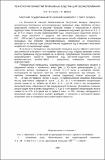| dc.contributor.author | Житенев, Борис Николаевич | |
| dc.contributor.author | Шеина, Людмила Евгеньевна | |
| dc.coverage.spatial | Брест | ru_RU |
| dc.date.accessioned | 2024-08-05T07:38:14Z | |
| dc.date.available | 2024-08-05T07:38:14Z | |
| dc.date.issued | 2004 | |
| dc.identifier.citation | Житенев, Б. Н.Технология обработки промывных вод станций обезжелезивания / Б. Н. Житенев, Л. Е. Шеина // Прыроднае асяроддзе Палесся: асаблівасці і перспектывы развіцця : матэрыялы міжнароднай навуковай канферэнцыі, Брэст, 16–18 чэрвеня 2004 г. : у 2 ч. / Нацыянальная акадэмія навук Беларусі, Адзел праблем Палесся ; рэдкал.: М. П. Ярчак [і інш.]. – Брэст : Академия, 2004. – Ч. 2. – С. 438–442. – Библиогр.: с. 442 (6 назв.). | ru_RU |
| dc.identifier.uri | https://rep.bstu.by/handle/data/44328 | |
| dc.description | Zhitenev, Boris Nikolaevich; Sheina, Lyudmila Evgenievna. Technology of processing of washing waters of iron removal stations | ru_RU |
| dc.language.iso | ru | ru_RU |
| dc.publisher | Академия | ru_RU |
| dc.title | Технология обработки промывных вод станций обезжелезивания | ru_RU |
| dc.type | Научный доклад (Working Paper) | ru_RU |
| dc.abstract.alternative | Backwash waters, which include iron components within the limits of 100...300 mg/l is formed as a result of operation of stations of iron removal from underground waters. Today the sludge unsets in the ground, polluting natural environment of Republic of Belarus and Polesie as well. The developed technology includes a treating of backwash waters by doses of reagent-precipitant and coagulant of 70 and 100 mg/l accordingly, residual concentration of iron after 2 hours settling compounded 0,5 ...0.6 mg/l, and for 4 hours - up to 0,3 mg/l. | ru_RU |
